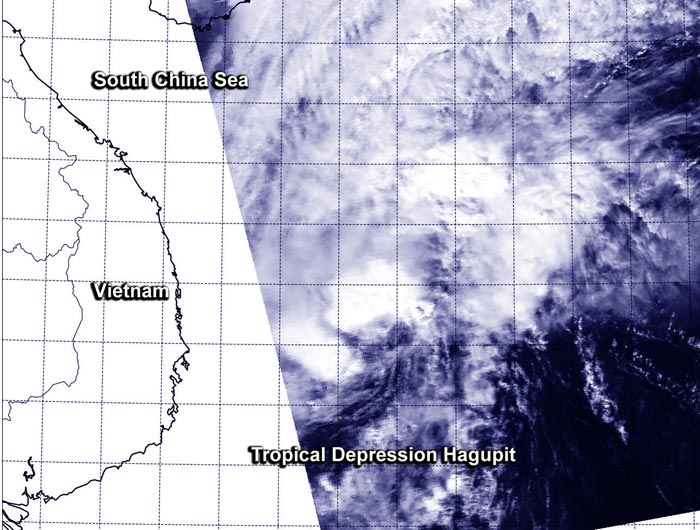NASA Sees Hagupit Weaken to a Depression Enroute to Vietnam

NASA's Aqua satellite passed over Hagupit on Dec. 11 at 05:20 UTC (12:20 a.m. EST) and saw thunderstorms had become fragmented around the circulation center. Image Credit: NASA/NRL
NASA's Aqua satellite passed over Hagupit on Dec. 11 at 05:20 UTC (12:20 a.m. EST) and the MODIS instrument captured a visible image of the storm.
The MODIS image showed that the thunderstorms had become fragmented around the circulation center.
On Dec. 11 at 1500 UTC (10 a.m. EST) Tropical Depression Hagupit's maximum sustained winds dropped to 30 knots (34 mph/55 kph).
It was centered near 12.8 north longitude and 110.9 east latitude, about 314 nautical miles (361 miles/581 km) east-northeast of Ho Chi Minh City, Vietnam. It was moving to the west at 8 knots (9.2 mph/14.8 kph).
The Vietnam National Centre for Hydro-meteorological forecasting has issued a tropical depression warning for southern Vietnam. For the latest forecasts and warnings, visit:
http://www.nchmf.gov.vn/Web/en-US/104/102/24189/Default.aspx
Hagupit is moving west-southwest toward southern Vietnam, where final landfall is expected around Dec. 12 at 0000 UTC. The system is forecast to dissipate quickly after landfall.
Rob Gutro
NASA's Goddard Space Flight Center
Media Contact
All latest news from the category: Earth Sciences
Earth Sciences (also referred to as Geosciences), which deals with basic issues surrounding our planet, plays a vital role in the area of energy and raw materials supply.
Earth Sciences comprises subjects such as geology, geography, geological informatics, paleontology, mineralogy, petrography, crystallography, geophysics, geodesy, glaciology, cartography, photogrammetry, meteorology and seismology, early-warning systems, earthquake research and polar research.
Newest articles

Bringing bio-inspired robots to life
Nebraska researcher Eric Markvicka gets NSF CAREER Award to pursue manufacture of novel materials for soft robotics and stretchable electronics. Engineers are increasingly eager to develop robots that mimic the…

Bella moths use poison to attract mates
Scientists are closer to finding out how. Pyrrolizidine alkaloids are as bitter and toxic as they are hard to pronounce. They’re produced by several different types of plants and are…

AI tool creates ‘synthetic’ images of cells
…for enhanced microscopy analysis. Observing individual cells through microscopes can reveal a range of important cell biological phenomena that frequently play a role in human diseases, but the process of…





















